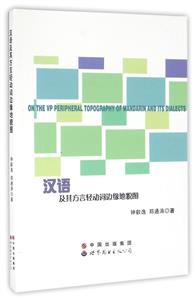掃一掃
關注中圖網
官方微博
本類五星書更多>
-
>
妙相梵容
-
>
基立爾蒙文:蒙文
-
>
我的石頭記
-
>
心靈元氣社
-
>
女性生存戰爭
-
>
縣中的孩子 中國縣域教育生態
-
>
(精)人類的明天(八品)
漢語及其方言輕動詞邊緣地貌圖 版權信息
- ISBN:9787519209353
- 條形碼:9787519209353 ; 978-7-5192-0935-3
- 裝幀:暫無
- 冊數:暫無
- 重量:暫無
- 所屬分類:>
漢語及其方言輕動詞邊緣地貌圖 本書特色
鐘叡逸、鄭通濤著的這本《漢語及其方言輕動詞邊緣地貌圖》主要研究漢語與方言輕動詞特征的對比,利用比較語法研究法法、制圖理論,以方言作為線索,梳理非典句式中的條理,探索客語的輕動詞邊緣,*終提出一幅地貌圖,幫助讀者掌握其句法特性以及相應的語義詮釋。*終鋪排客語輕動詞邊緣地貌圖,以期更清晰地掌握輕動詞邊緣,并同時進行跨語言比較,藉此突顯個別語言的特色,點明語言之間的通則和個性。
漢語及其方言輕動詞邊緣地貌圖 內容簡介
本書主要研究漢語與方言輕動詞特征的對比,本書利用比較語法研究法法、制圖理論,以方言作為線索,梳理非典句式中的條理,探索客語的輕動詞邊緣,*終提出一幅地貌圖,幫助讀者掌握其句法特性以及相應的語義詮釋。*終鋪排客語輕動詞邊緣地貌圖,以期更清晰地掌握輕動詞邊緣,并同時進行跨語言比較,藉此突顯個別語言的特色,點明語言之間的通則和個性。
漢語及其方言輕動詞邊緣地貌圖 目錄
CHAPTER 1 INTRODUCTION 1.1 Background: the Hakka Dialects 1.2 The Theoretical Background: the Cartographic Approach 1.2.1 Three - Layer Configuration 1.2.2 A Rigid and Invariant Universal Structure 1.2.3 Cartography and Minimalism 1.3 Research Issues and Questions: Cartography of vP Periphery in Hakka 1.3.1 Argument Structures 1.3.2 Syntactic Hierarchy and Sentential Linearization 1.3.3 Cartographic Approach in Analytic Languages 1.4 Blueprint of ThesisCHAPTER 2 THE DISPOSAL CONSTRUCTIONS IN HAKKA 2.1 Introduction: Disposal JIONG versus BA 2.2 Literature Reviews 2.2.1 Hakka Disposal Construction: 2.2.2 Chinese BA Construction 2.2.3 The Development of Jiang 將 Construction 2.3 Two Types ofjiong Constructions in Hakka 2.3.1 Optional/Obligatory Possession & Inalienable NP 2.3.2 Two Types of fiong: Disposal and Affective 2.4 The Proposal 2.4.1 The Locus and the Structure 2.4.2 Jiong- Construction in a Broad Perspective 2.4.2.1 Co -occurrence: Supporting Evidence for Distinct Syntactic Position 2.4.2.2 Cross - linguistic Comparison : Disposals and Affectives 2.4.3 Affectedness 2.5 ConclusionCHAPTER 3 THE AFFECTIVE CONSTRUCTIONS IN HAKKA 3.1 Introduction: Extra -Argument Licensing 3.2 Literature Reviews 3.2.1 Bipartite Applicatives ( Pylkkanen 1999, 2002 ; McGinnis 2001, 2005 ) 3.2.2 Tripartite Applicative Constructions (Tsai 2007, 2009, 2011 ) 3.3 Two Types of Affective Constructions 3.3.1 Basic Facts 3.3.2 The Nature of tung 3.3.2.1 Cantonese tung ( Matthews and Yip 1994 ; Matthews 2006 ; Tang 2009 ) 3.3.2.2 Hakka tung 3.3.3 Inner Affective Constructions : Pseudo - DOC & tung - construal 3.3.4 Outer Affective Constructions : tung Construals 3.3.5 The Proposed Structure of the Hakka Affective Constructions 3.4 The Argument Introducers 3.4.1 Possible Introducing Strategies 3.4.2 Case Study : fiong - Affectives and tung - Affectives 3.5 ConclusionCHAPTER 4 THE AFFECTIVES IN BROAD PERSPECTIVES 4.1 Introduction: the Picture of Affeetive Constructions 4.2 Interactions with vP - Peripheral Elements 4.2.1 Light Verbs and Affeetives 4.2.2 Adverbials and Affeetives 4.2.3 Intermediate Summary 4.3 Multiple Affectives 4.3.1 The Combinations: Marked + Marked/Marked + Unmarked 4.3.2 The Proposed Structure 4.4 Affectives and Disposals 4.4.1 Ka -Hoo constructions in Taiwan Southern Min 4.4.2 The Combination : Affective ( tung, pseudo - DOC) & Disposal (fiong, 4.4.3 Proposed Structure : the Topography of the vP Periphery 4.5 The Grammatiealization : the origin of Affective constructions 4.5.1 A Coincidence Perspective (Tsai et al 2008) 4.5.2 What an Affective Construction can be?
4.6 ConclusionCHAPTER 5 THE POSTVERBAL MODAL PROJECTIONS IN HAKKA 5.1 Introduction 5.2 Literature Reviews 5.2.1 Postverbal Modals 5.2.2 The Syntax of Complex Heads 5.3 The Proposal: Three Types of TET Construction 5.3.1 The Nature of tet: an Affixal Modal 5.3.2 Two Procedures/Strategies: Move and Merge 5.3.3 (A) symmetries among Three Types of tet 5.3.4 Intermediate Summary 5.4 Tet in Comparative Perspectives 5.5 ZOTET : zo - tet ( v - Mod) to ZOTET 5.6 ConclusionCHAPTER 6 VP PERIPHERAL AREA IN HAKKA 6.1 Introduction 6.2 Interactions within vP - Peripheral Elements 6.2.1 Modal tet and Adverbials 6.2.2 Modal tet and Light Verb Construals 6.2.3 Modal tet and Affective Constructions 6.2.4 Intermediate Summary 6.3 Cross - linguistic Comparison 6.3.1 Modals 6.3.1.1 Mandarin Chinese : modality and subject specificity 6.3.1.2 Modal tet in Hakka dialects 6.3.2 Argument Arrangement 6.3.2.1 Disposals 6.3.2.2 Affectives 6.4 The Topography of Peripheral Area 6.5 ConclusionREFERENCESAPPENDIX: THE LIST OF ABBREVIATIONS
展開全部
書友推薦
- >
自卑與超越
- >
龍榆生:詞曲概論/大家小書
- >
姑媽的寶刀
- >
隨園食單
- >
我從未如此眷戀人間
- >
【精裝繪本】畫給孩子的中國神話
- >
小考拉的故事-套裝共3冊
- >
羅庸西南聯大授課錄
本類暢銷

















